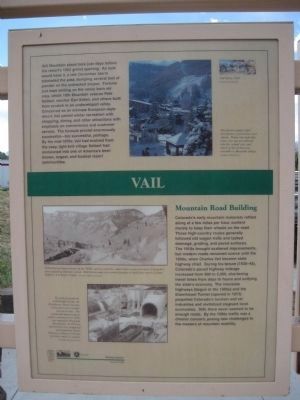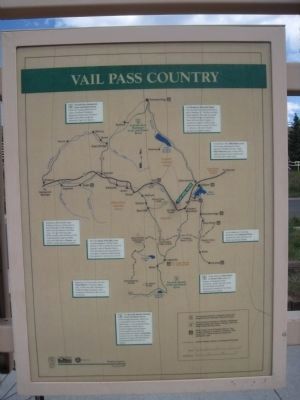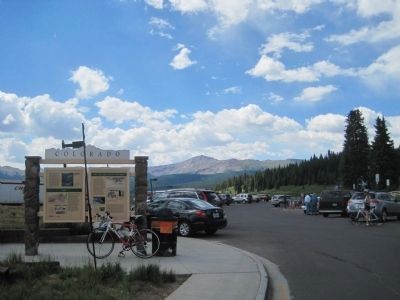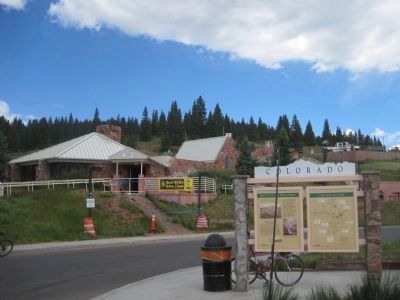Vail Pass in Summit County, Colorado — The American Mountains (Southwest)
Vail / Vail Pass Country
Vail Mountain stood bare just days before the resort’s 1962 grand opening. As luck would have it, a late December storm blanketed the area, dumping several feet of powder on the untracked slopes. Fortune just kept smiling on the newly born ski area, which 10th Mountain veteran Pete Seibert, rancher Earl Eaton, and others built from scratch in an undeveloped valley. Conceived as an intimate European-style resort, Vail paired winter recreation with shopping, dining, and other attractions with emphasis on convenience and customer service. The formula proved enormously successful—too successful, perhaps. By the mid-1970s, Vail had evolved from the cozy, tight-knit village Seibert had envisioned into one of America’s best-known, largest, and busiest resort communities.
Mountain Road Building
Colorado’s early mountain motorists rattled along at a few miles per hour, content merely to keep their wheels on the road. Those high-country routes generally followed old wagon trails and lacked drainage, grading, and paved surfaces. The 1910s brought scattered improvements, but modern roads remained scarce until the 1930s, when Charles Vail became state highway chief. During his tenure (1930-45), Colorado’s paved highway mileage increased from 500 to 5,000, shortening travel times from days to hours and unifying the state’s economy. The interstate highways (begun in the 1950s) and the Eisenhower Tunnel (opened in 1973) propelled Colorado’s tourism and ski industries and revitalized stagnant local economies. Still, there never seemed to be enough roads. By the 1990s traffic was a chronic concern, posing new challenges to the masters of mountain mobility.
On the Marker Reverse is a map with caption boxes identifying local scenery and accomplishments. Clockwise from upper left, they read:
Colorado River Headwaters Scenic and Historic Byway follows the Colorado River from its source in the Rocky Mountains, beginning at Grand Lake, Colorado’s largest natural lake, through the spectacular Upper Gore Canyon
The Eisenhower Memorial Tunnel bores through the Continental Divide as part of Interstate 70. The first, two-lane tunnel opened in 1973 and was named for President Dwight D. Eisenhower, whose wife was from Colorado. A second bore opened in 1980 for east-bound travel and was named for Edwin C. Johnson, a two-term Colorado Governor and longtime senator.
Completed in 1963, Dillon Dam created a five-square-mile reservoir with a capacity of 254,036 acre-feet. Today, Dillon Reservoir plays a major role in supplying Denver and its suburbs with more than 20% of their water.
As the backbone of the Rocky Mountains, the Continental Divide separates the waters flowing to the Pacific and Atlantic Oceans.
On the outside the Healy House and Dexter Cabin display two extremes of nineteenth-century architecture. Inside, they both contain fine furnishings and detailed appointments, testament to the mining wealth that built Leadville.
The Top of the Rockies National Scenic and Historic Byway travels through spectacular scenery and is surrounded by some of the state’s highest peaks. In the nineteenth century, these mountains yielded some of Colorado’s biggest mining fortunes. In the twentieth century, the 10th Mountain Division trained at Camp Hale, located on U.S. 24. Many of its veterans returned to Colorado after World War II and helped establish the state’s ski industry.
Measuring 14,433 feet above sea level, Mount Elbert is Colorado’s highest peak. Of the sixty-eight “forteeners” – 14,000-foot-high mountains- in the continental United States, fifty-four are in Colorado.
When the Mount of the Holy Cross was photographed by William Henry Jackson in 1873 it entered the lexicon of America’s ideal of Manifest Destiny. Poets and painters later immortalized it, and hordes of pilgrims trekked through the mountains to see this cross of snow..
Entrepreneur David Moffat began building the Denver, Northwestern & Pacific Railroad in 1903 intending to build a line from Denver to the West Coast. Not until 1934 (long after Moffat’s death), when the Denver & Rio Grande Railroad bought the DN&P tracks and linked them to Dotsero, was Moffat’s transcontinental line realized.
Erected 2001 by Colorado Historical Society and the Colorado Department of Transportation. (Marker Number 246.)
Topics and series. This historical marker is listed in these topic lists: Industry & Commerce • Roads & Vehicles • Sports. In addition, it is included in the Colorado - History Colorado, and the Former U.S. Presidents: #34 Dwight D. Eisenhower series lists. A significant historical year for this entry is 1962.
Location. 39° 31.652′ N, 106° 13.083′ W. Marker is in Vail Pass, Colorado, in Summit County. Marker is on Shrine Pass Road (County Road 16) near Interstate 70. At the Vail Pass rest area, off Interstate 70. Touch for map. Marker is in this post office area: Frisco CO 80443, United States of America. Touch for directions.
Other nearby markers. At least 8 other markers are within 10 miles of this marker, measured as the crow flies. Mount of the Holy Cross (here, next to this marker); 10th Mountain Division (here, next to this marker); Stone Huts (approx. 4.1 miles away); Foote's Rest (approx. 7.3 miles away); Staley-Rouse House (approx. 7.3 miles away); "Ski for Light, Art for Sight" (approx. 7˝ miles away); Construction of Camp Hale (approx. 8.4 miles away); Kokomo Masonic Lodge (approx. 9.6 miles away). Touch for a list and map of all markers in Vail Pass.
More about this marker. There are four pictures on the front side of this marker. From upper right to the bottom, they have the following captions:
Vail Valley, 1985
Courtesy Vail Resorts
Two factors guided Vail’s developers—convenience and charm. Slopes run right into town, cars are not allowed into the central core, and much of the architecture resembles a Bavarian village.
Courtesy Vail Resorts
Technological improvement in the 1920s, such as concrete, added miles of paved road to Colorado’s ever-expanding highway system. Both horses and cars worked together to build this stretch of State Highway 4 in Eagle County.
Colorado Historical Society
By going beneath the Continental Divide, the Eisenhower Tunnel became Colorado’s most reliable east-west route. The westbound tunnel (shown under construction in 1970) was named for President Eisenhower. In 1979 an eastern bore was completed and named for Edwin Johnson, a former Colorado governor and U.S. senator.
Colorado Historical Society
Credits. This page was last revised on June 16, 2016. It was originally submitted on August 17, 2012, by Kevin W. of Stafford, Virginia. This page has been viewed 793 times since then and 37 times this year. Photos: 1, 2, 3, 4. submitted on August 17, 2012, by Kevin W. of Stafford, Virginia.



